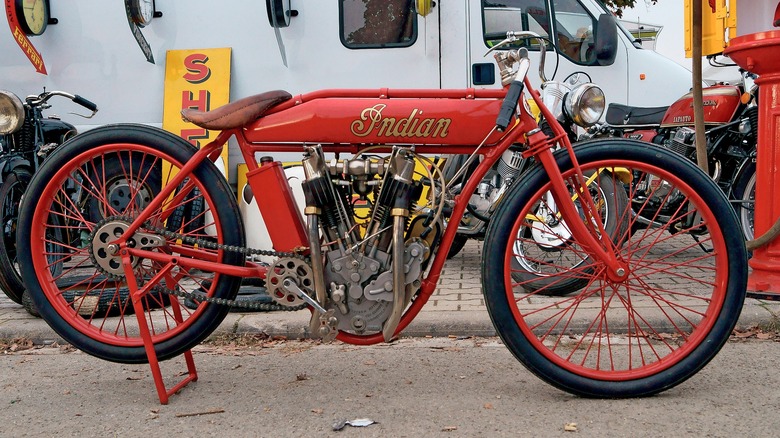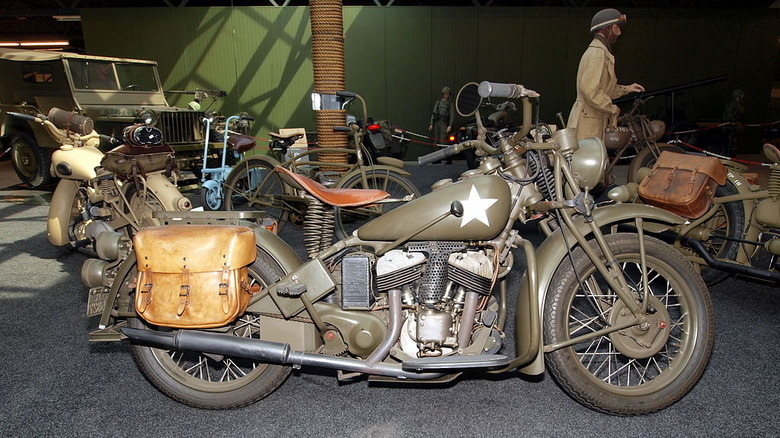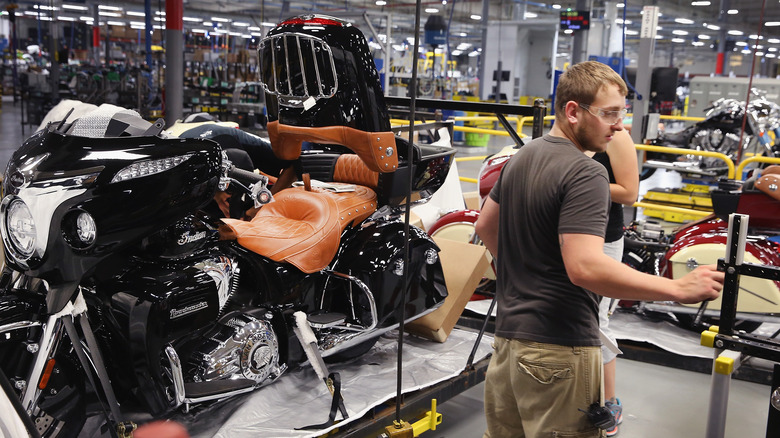Where Are Indian Motorcycles Made, And Who Owns The Company Now?
No, Harley-Davidson was not the first American motorcycle company. That honor goes to the Indian Motorcycle Company, which at the time was called the Hendee Manufacturing Company. Today, Indians are still made in the U.S. and owned by a company better known for its snowmobiles, but that wasn't always the case. In fact, its history has more twists and turns than San Francisco's Lombard Street ("Crookedest Street in the World") and more mystery and intrigue than a Harlan Coben novel.
Like many early motorcycle pioneers, George M. Hendee was a bicycle racer and manufacturer. He started the Hendee Manufacturing Company in 1897. As the century turned over, Hendee hired Oscar Hedstrom in 1901 as his chief engineer to fabricate gas-powered bikes that could keep pace with the speeds of the pedal-powered racers. That same year — and as motorcycles started to gain traction in the United States — the pair opened the company's first factory in downtown Springfield, Massachusetts. This was a full two years before William S. Harley and the Davidson brothers got together in Milwaukee.
And here's an interesting albeit conflicting bit of history: The first "production" motorcycle in the U.S. wasn't built by either Harley or Hendee but by the Waltham Manufacturing Company (founded in 1893) when Charles H. Metz unveiled the Orient-Aster in 1899. Unless you're a hardcore motorcycle enthusiast, you've likely never heard of the Orient or Waltham Manufacturing Company. Apparently, history really is written by the victors.
[Featured image by Qflieger via Wikimedia Commons | Cropped and scaled | CC BY-SA 3.0]
Even world wars couldn't keep the Indian alive
In 1913, the U.S. Army started using Hendee (not yet called Indian) bikes, the same year co-founder Oscar Hedstrom resigned from the company. The world entered its first war in July 1914. Hendee left as general manager in 1915 but remained as president. The United States entered WWI in April 1917, and the company immediately began diverting production toward the war effort. Between 1917 and 1919, it built almost 50,000 motorcycles for the Army.
In 1923, the name was finally changed to The Indian Motocycle Company (notice the missing "r"). Fifteen years later in 1930, Eleuthère Paul du Pont — business magnate and founder of Du Pont Motors — purchased enough shares in the company to force existing management out. He subsequently puts his own man, Loring F. Hosley, in charge, who in turn grows the company exponentially. Between 1940 and 1945 (the World War II years), production again shifted entirely to the war effort, and Indian made some 35,000 bikes (equating to $24 million worth of inventory) for the military.
In 1950, Ralph B. Rogers resigned as president of Indian Motorcycle and was summarily replaced by John Brockhouse, a third-generation English industrialist whose family was into forging springs, axles, and other ironworks. Three short years later, in 1953, the company shut down entirely and remained shuttered for the next two years. Brockhouse Engineering bought the rights to the company in 1955 and, oddly, started importing Royal Enfield motorcycles (which has a crazy history of its own), rebranded them, and sold them as Indian Motorcycles.
[Featured image by AlfvanBeem via Wikimedia Commons | Cropped and scaled | CC BY-SA 1.0]
Snowmobiles saved the Indian
By 1960, sales had diminished to the point that Brockhouse sold off what was left of Indian to the Associated Motorcycle Company (AMC), which owned several motorcycle brands, including Norton. Shortly after the buyout, however, the Indian Motorcycle Company faded away.
In 1963, Floyd Clymer took up the challenge and bought the scraps of Indians. Clymer is a true legend in the motorcycle world and both a Motorcycle Hall of Fame and Motorsports Hall of Fame of America inductee. He followed Brockhouse's business model by importing Royal Enfield and Velocette bikes and slapping them with an Indian badge. This lasted until Clymer died in 1970, and his attorney assumed ownership of the company. He limps it along for seven more years, but he too is forced to close the doors on Indian in 1977.
The Indian name sat idle for over 20 years until nine companies merged to form the Indian Motorcycle Company of America (IMCA) in 1998. Their production facility was located in Gilroy, California (the "Garlic Capital of the World"), and they set about making modified versions of two of the best Indian lines ever made, the Chief and Scout. Unfortunately, history repeated itself when the company went bankrupt five years later in 2003.
The following year, London-based private equity firm Stellican Ltd. picked up the pieces, built a manufacturing facility in King's Mountain, North Carolina, and began selling Indian-branded bikes again. It was then sold to Polaris Industries (famous for snowmobiles) in 2011, which moved operations to Spirit Lake, Iowa, and still owns, operates, and builds Indian motorcycles there today.


